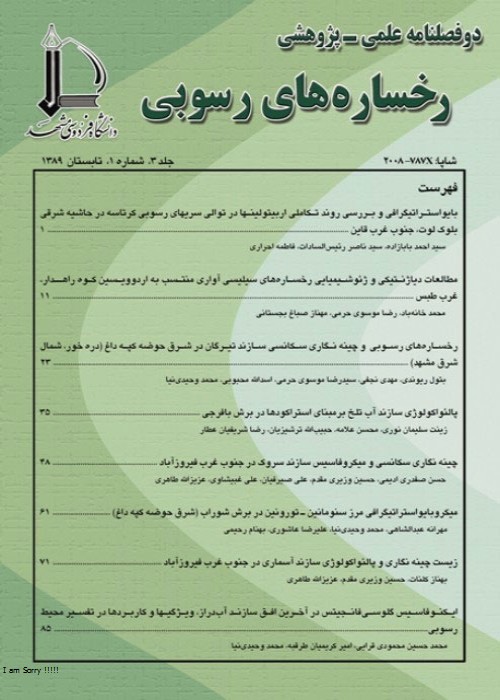Ammonite and Nannofossil Biozonation of the Aitamir Formation in Eastern Kopet-Dagh Basin (Amirabad section)
The Kopet-Dagh Basin is located in the northeast of Iran, extended over Iran, Turkmenistan, and Afghanistan with a west-northwest to east-southeast trend. The Iranian part of the basin is located between 61°14ˊ and 54°00ˊE and 38°16ˊ and 36°00ˊ N. Cretaceous successions are thick and well exposed in the northeast of Iran. The Cretaceous Ammonites are studied by Seyed-Emami (1980), Seyed-Emami & Aryai (1981), Seyed-Emami et al. (1984), Immel et al. (1997), Raisossadat (2004, 2006), Mosavinia et al. (2007, 2014), and Mosavinia & Wilmsen (2011). Calcareous nannoplankton biostratigraphy of Aitamir formation is studied by Susani (2005) and Hadavi & Musazadeh (2005).
The studied section, the Amirabad section, is located at a distance of 65 km to the northeast of Mashhad city, on the Mashhad-Kalat road (coordinates: N36°34ˊ59˝ and E60°09ˊ24˝; altitude: 720 m). Aitamir Formation is measured 668 m in this section and comprised siltstones, fossiliferous (bivalve and ammonite) sandstones, glauconitic sandstones, dark gray to greenish-gray silty shales, and dark gray shales. It conformably overlies the Sanganeh Formation and is overlain by the Abderaz Formation. A total of 139 samples were collected from the section at intervals 3-5 m to study the calcareous nannofossils. In addition, 40 m part of the topmost of the underlying Sanganeh Formation as well as the lowermost of the overlying Abderaz Formation were also measured and sampled. For nannofossil biostratigraphic investigations, all samples were processed using the gravity settling technique (Bown & Young, 1998). The prepared slides were observed under a Nikon Optiphot II Pol light microscope with a magnification ×1000. Bibliographic references for the calcareous nannofossils are given in Perch-Nielsen (1985), Varol (1992), and Burnett (1998). Ammonite samples were collected across the section and named and photographed at the paleontology laboratory of the Payam-e-Noor University of Mashhad.
Nannofossil bioevents have been utilized to biostratigraphically classify the exposed sedimentary succession based on the CC biozonation scheme of Sissingh (1977, modified by Perch-Nielsen, 1985) and the NC biozonation scheme of Roth (1978, modified by Bralower et al., 1995). The biozones CC8 to CC10 and NC9 to NC13 were determined, and accordingly, the Aitamir Formation is attributed to Albian to late Cenomanian time interval. The lithology of sandstones and siltstones at the lower part of the Aitamir Formation influenced the preservation of nannofossil taxa. In this part, the Ammonite biozones have covered the gap of nannofossil biozones. The upper part of Leymeriella tardefurcata, Hoplites dentatus, Euhoplites loricatus, Euhoplites lautus Mortoniceras (M.) inflatum, Stoliczkaia dispar, Mantelliceras mantelli, Mantelliceras dixoni, Cunningtoniceras inerme and Acanthoceras rhotomagense biozones were determined at the Aitamir Formation except for the upper 20 meters, which contains no ammonite sample. Based on Ammonite biozones, the age of Late Early Albian to Middle Cenomanian is attributed to the Aitamir Formation.
Negor , The whale , fossil , Sedimentology , Index fossil
-
Biostratigraphy of the Gurpi Formation in Chenareh section based on calcareous nannofossils
Zeinab Bayat, Anoshiravan Lotfali Kani *, Jahanbakhsh Daneshian
Stratigraphy and Sedimentology Researches, -
Nannostratigraphy of the Surgah Formation at Posht-e-Jangal and Pasan stratigraphic sections – with special seference to Turonian-Coniacian and Coniacian-Santonian boundaries
Kamyar Younesi, Anoshiravan Lotfali Kani *, Hormoz Ghalavand
Geosciences Scientific Quarterly Journal,



